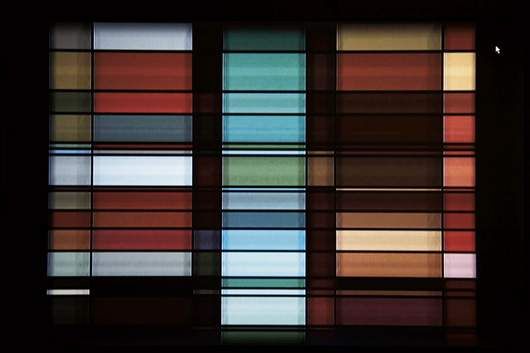
From "Jeremy Blake in Three Parts," written by editor/curator Bennett Simpson for PS 1's "Greater NY" show. In 2000, Blake's 20-min. digitally animated abstraction titled Angel Dust was in both the harried, hasty "Greater NY" and the Pompidou's "Elysian Fields", a sublime show for which Simpson curated an incredible sound program:
I.The other two parts are after the jump. An edition of Angel Dust is coming up at auction at Phillips in a couple of weeks.
In the new art game, machine language is the best kind of pragmatism. Because you've never had so many options, your tools should work for you. There is still such an impoverished discourse around art made with "new media" that it benefits everyone to be dexterous (or at least flexible). Jeremy Blake tells me it took months to program his latest digital animation Angel Dust. I believe him. Line for line, the amount of coding, sequencing, and editing involved is staggering. As is more and more the case with art's flirtation with technology, the hours logged and the efforts involved are right on the surface -- and in a way, this is part of the point. Skill is transparent. Insofar as Angel Dust can be called abstract art, its abstraction is one of trial and error, micro-production, shortcuts, good fortune, lots of practice, lots of knowledge, and an appreciation of possibilities. I'm not only speaking about the animation's formal qualities or its methods of production. If abstraction is now the domain of distributed and integrated systems of information, then the function of Angel Dust's content -- its seething Mondrian grid, its Burbank-rolled narrative tics, and its psychedelia -- is no different from its code. Blake makes programmed art works: the what and how are symptomatic of each other.
II.It's midnight in Aspen. Ralph Lauren is breeding wolves to salivate at
blue-screens. The NDA kids are whispering at the pine trees. They say ". . ." The under staffs of eight non-ranking members of the IMF Sub-Committee on Internal Allocations sit around a conference table made from split basalt. They drink grass tea or water. Most of them prefer not to talk. The thrum of knuckle-typing interfaces, the occasional sigh, someone abruptly speaking into a hidden phone: "She did. I know. Fairfax." Third shift meetings are like snow drifts: fractal bits of frozen liquid blown around by winds no one can control. Outside the VistaFlex bay windows, teenagers in headphones and brow lanterns are cutting down a hill on their boards. One of them is called Berkley or Damon or Finn. His father exec-produces movies you would know, if he was allowed to tell you their names. Berkley or Damon or Finn is fucked up on something he smoked. He feels like beetles are swarming up his spine. He feels like puking up Master P beats or the flute line from "Aqua Lung." His neck throbs. He pages his girlfriend just before he blacks out in a bush.III.
What is Angel Dust? Looped riffs on the history of modernist design? Control vs. Excitation vs. Entropy? Cinema reflected through a visual culture no longer predicated on the formal dynamics of cinema? First and foremost, Angel Dust is a collection of procedures and images activated by digital technology. As such it's state-of-the-art. A more difficult to talk about aspect of Blake's work is its psychological gestalt-the ambient quality that evokes states of consciousness, modes of abstract thought, psycho-somatic deconditioning. What happens when you collide powerful disruption (induced by drugs or not) with powerful aesthetic narratives? What's hallucinogenic about architecture? About the grid? About the social
world of deep money and luxe living? These are questions that art has only just begun to try to ask, much less answer. In this hyper-mediated period of integration and experiment-witness NASDAQ, AOL-Time Warner, the rise of computer-inflected art practice-the subjects broached by artists will and must change. It's work like Angel Dust that reboot the system.
Bennett Simpson
2/27/00












